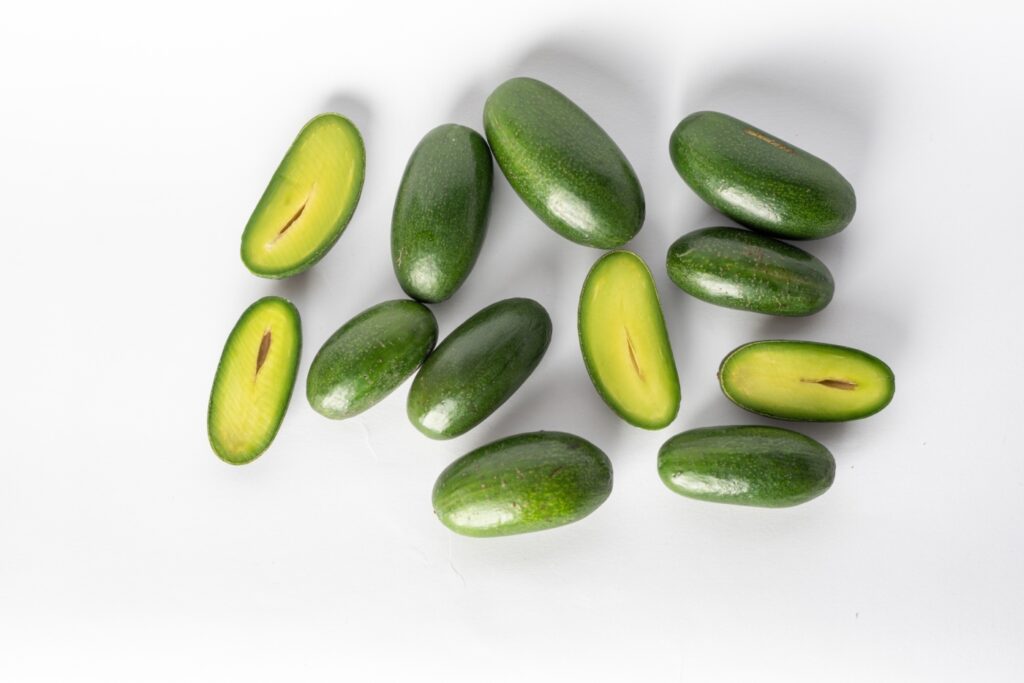
Q: I have an avocado tree that is over 50 years old. It produces delicious fruit that I love to watch as they grow to maturity. However, over the years I’ve noticed that a portion of them (maybe 10-20%) stop growing & end up looking like small hot dogs. This occurs all over the tree, so I know it’s not from disease. Maybe it’s because the tree is so old? Do you have any remedies for me?
A: Usually, whenever fruit fails to develop, it’s a pollination issue.
Avocados can be classified as “A” or “B” type. Type A flowers are female in the morning and male in the afternoon. Type B flowers are male in the morning and female in the afternoon. Pollination can be improved if you have at least one of each type, but that’s not absolutely necessary for fruit production.
Temperature during flowering can affect pollination and fruit development as well. For the best fruit set, the temperature should be between 65 and 75F.
When pollination goes wrong, sometimes the fruit will stay small and be elongated. These are often sold as “Finger” or “Cocktail” avocados. Don’t ask me what to do with them – I can’t imagine that there would be much to eat once you peel them!
Q: I live in Southern California, and I can often over-winter tomato plants. Sometimes, late in the original plant’s season, I will pull off a branch and start it in another pot which thrives through the next summer. Sometimes I cut finished tomato plants down to a trunk and a few leaves, only to see them take off and bear another huge crop of tomatoes!
In December, our temperatures have gotten quite cool (59 day and 44 night). I brought a dozen green tomatoes inside and put them on a windowsill to ripen. They slowly do, and taste almost as good as vine ripened. How, or what makes the tomatoes keep on ripening indoors?
A: Tomatoes in December, or even January, is what makes gardening in Southern California so different from gardening in the rest of the country.
When your tomato plants are looking so ratty that you can’t stand it anymore, they can still have some decent-looking green tomatoes clinging to them. As you pull out the old vines (or clip them back), look for fruits that are unblemished and slightly blushed. If possible, leave a little bit of stem attached, since this seems to hasten the ripening process.
Related links
How to use and preserve different types of tomatoes from the garden
How to get ready for spring gardening
Tomato growing cheat sheet: Sign up for the Garden Party newsletter
For best results, the fruit can be kept in a paper bag or cardboard box. Some people like to wrap each one in newspaper to prevent bruising and improve ripening. The fruit will give off ethylene gas, which will cause it to turn red. Wrapping it will speed up the ripening process since the gas will be trapped near the fruit. Leaving the fruit on a windowsill results in slower ripening, but probably less waste since you can keep an eye on them.
If you like to can tomatoes (or recipes using fresh tomatoes) keep in mind that you cannot safely use cold damaged tomatoes for this purpose because their acid content is significantly lower than vine-ripened tomatoes.
Have questions? Email gardening@scng.com.
Looking for more gardening tips? Here’s how to contact the Master Gardener program in your area.
Los Angeles County
mglosangeleshelpline@ucdavis.edu; 626-586-1988; http://celosangeles.ucanr.edu/UC_Master_Gardener_Program/
Orange County
ucceocmghotline@ucanr.edu; 949-809-9760; http://mgorange.ucanr.edu/
Riverside County
anrmgriverside@ucanr.edu; 951-683-6491 ext. 231; https://ucanr.edu/sites/RiversideMG/
San Bernardino County
mgsanbern@ucanr.edu; 909-387-2182; http://mgsb.ucanr.edu/
Related Articles
This edible plant almost went extinct 500 years ago. Now it grows well everywhere
How to treat leaf curl on a peach tree
Why this fruit-bearing California native plant is great for your garden
Learn with Garden Party and SCNG’s other virtual programs
Early spring is when to be on the lookout for these garden pests
